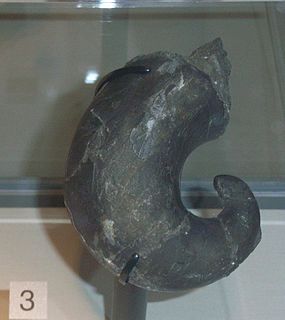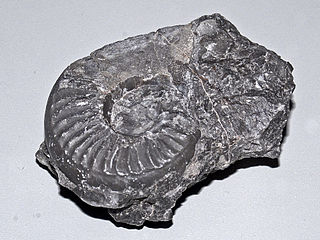
The Nautilida constitute a large and diverse order of generally coiled nautiloid cephalopods that began in the mid Paleozoic and continues to the present with a single family, the Nautilidae which includes two genera, Nautilus and Allonautilus, with six species. All told, between 22 and 34 families and 165 to 184 genera have been recognised, making this the largest order of the subclass Nautiloidea.

The Oncocerida comprise a diverse group of generally small nautiloid cephalopods known from the Middle Ordovician to the Mississippian, in which the connecting rings are thin and siphuncle segments are variably expanded. At present the order consists of some 16 families, a few of which, such as the Oncoceratidae, Brevicoceratidae, and Acleistoceratidae contain a fair number of genera each while others like the Trimeroceratidae and Archiacoceratidae are represented by only two or three.
The Rutocertina is one of only three suborders in Shimankiy's (1957) classification of the Nautilida, the other two being the Lirocerina and Nautilina. Genera in the Rutocerina are redistributed in the Rutoceratina, Tainoceratina, and Centroceratina. The Lirocerina is redefined as the Liroceratina, and Nautilina.remains as is. In general terms these are similar to the simpler classification proposed by Kümmel 1964, wherein the Nautilida is divided into five superfamilies, the Tainocerataceae, Trigonocerataceae, Clydonautilacea, Aipocerataceae, and Nautilaceae. Shimanskiy's classification involves 34 families, Kümmel's only twenty-seven.
Strophiceras is an extinct genus of cephalopods from the Order Nautilida, which includes, in a separate family, Nautilus and Allonautilus.
Homaloceras is an extinct nautiloid cephalopod from the Middle Devonian with a strongly curved shell, included in the nautilid family Centroceratidae.
Valhallites is an extinct genus in the nautiloid order Nautilida which includes the living Nautilus found in the tropical western Pacifiic. Valhalites belongs to the Koninckioceratidae, a family in the Tainoceratacea, a nautilid superfamily.
The Tainoceratoidea are a superfamily in the cephalopod order Nautilida characterized by straight to loosely coiled shells, generally to a degree such that the width is greater than the height, to quadrate whorl section. Many bore spines, ribs, frills, wings, or nodes. In early forms, the siphuncle is generally near ventral, but more variable in advanced forms.
Basslerocerida is an order of nautiloid cephalopods from the Ordovician comprising exogastric longiconic cyrtocones, that is no longer in common use.
The Clydonautiloidea are a superfamily within the nautiloid order Nautilida characterized by smooth, generally globular, shells with nearly straight sutures, in early forms, but developing highly differentiated sutures in some later forms. Where known, the siphuncle tends to be central to subcentral.

The Trigonoceratoidea are a superfamily within the Nautilida that ranged from the Devonian to the Triassic, thought to have contained the source for the Nautilaceae in which Nautilus is found.
For a further discussion of this group as in use today, see the superfamily Tainocerataceae

Grypoceratidae is the longest-lived family of the Trigonoceratoidea, or of the near equivalent Centroceratina; members of the Nautilida from the Upper Paleozoic and Triassic.
The Trigonoceratidae is a family of coiled nautiloid cephalopods that lived during the period from the Early Carboniferous (Mississippian) to the Early Permian.
The Centroceratidae is the ancestral family of the Trigonoceratoidea and of the equivalent Centroceratina; extinct shelled cephalopods belonging to the order Nautilida

The Aipoceratoidea are a superfamily within the order Nautilida characterized by rapidly expanding, smooth to ribbed, cyrtoconic to coiled shells with rounded or sometimes dorsally flattened or impressed whorls, nearly straight sutures, and a ventral and marginal siphuncle. Septal necks are orthochoanitic ventrally and orthochoanitic or cyrtochoanitic dorsally.
Liroceratidae is an extinct family of nautilids, shelled marine molluscs, belonging to the Clydonautiloidea, consisting of generally smooth, involute, nautiliconic forms with a small umbilicus. The whorl section is usually depressed and broadly rounded, the suture only slightly sinuous, and the siphuncle usually more or less central.

Trochoceras is a genus of trochoidally coiled nautiloid cephalopods placed in the nautilid family Rutoceratidae that lived during the Middle and Late Devonian in what is now central Europe.

Tainoceratidae is a family of late Paleozoic and Triassic nautiloids that are a part of the order Nautilida, characterized by large, generally evolute shells with quadrate to rectangular whorl sections. Shells may bear ribs or nodes, or both.
The Tetragonoceratidae is a small family of nautilitids constituting a part of the superfamily Tainocerataceae in which shells are coiled with a generally quadrate whorl section. Coiling is either gyroconic or evoluute with a slight dorsal impression. Flanks diverge from the umbilical to the ventral shoulders so as to make the whorl sections widest close to the venter. Nodes made develop on the flanks and shoulders. The siphuncle is tubular, typically found near the venter. Sutures are with lateral lobes and may possess dorsal and ventral lobes as well.
Capriocornites is a genus of rutoceratids from the Devonian, related to such genera as Rutoceras and Goldringia.






